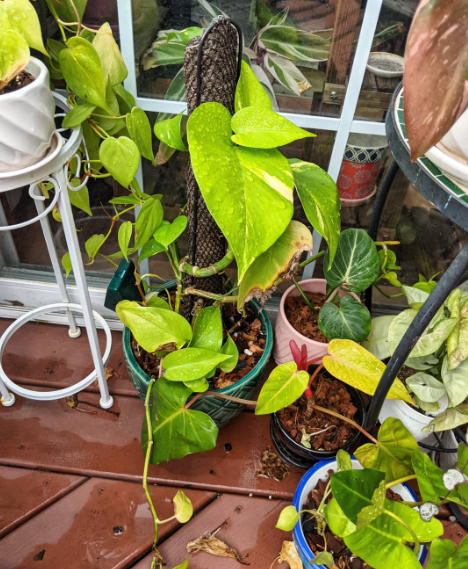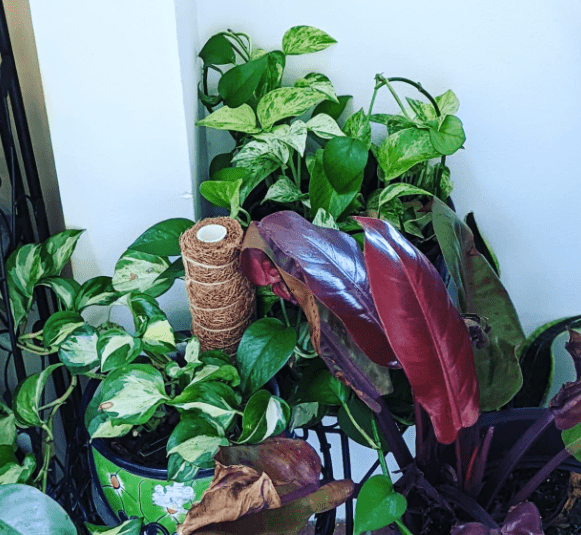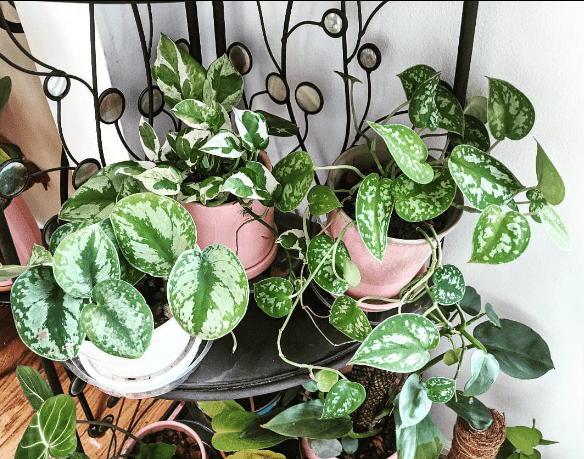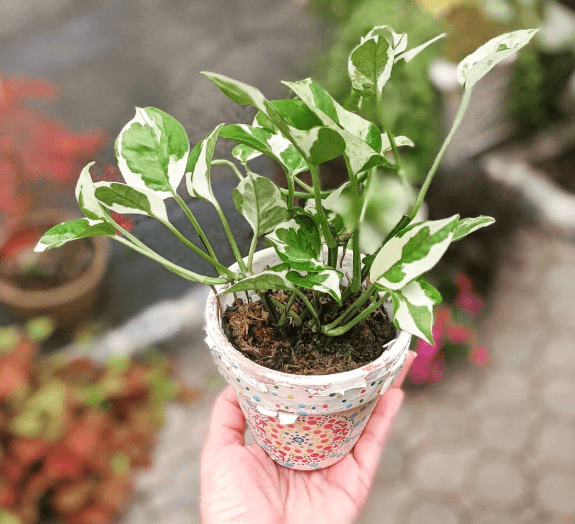Pothos, often referred to as devil’s ivy, are remarkably adaptable plants. They can thrive in a variety of indoor and outdoor environments. A lanai, with its semi-outdoor setting, can actually create an ideal space for your pothos to flourish.
But before you move your pothos outdoors, it’s essential to consider a few key factors that will ensure its success. Let’s dive into the details of growing pothos on a lanai.
People Also Read: When to Plant Siberian Ginseng in Michigan for Best Results
Understanding Lanais
A lanai is a screened-in or windowed outdoor space, commonly found in tropical or subtropical climates. It provides protection from harsh weather elements while allowing ample sunlight and airflow. Lanais are excellent for plants because they offer a semi-outdoor environment that mimics a plant’s natural habitat.
Benefits of Planting on a Lanai
- Better Airflow: A lanai provides better airflow compared to indoor environments. This helps to prevent fungal growth and mildew on your plant’s leaves, promoting a healthy growth environment.
- Controlled Sunlight: Lanais allow you to control the amount of sunlight your pothos receives. This is crucial as pothos prefer indirect light, which a shaded or partially shaded lanai can provide.
- Protection from Elements: While still enjoying the outdoors, a lanai offers some protection from rain, wind, and extreme temperatures, making it suitable for sensitive plants like pothos.
- Aesthetic Enhancement: Pothos with their trailing vines can transform your lanai into a lush, tropical oasis. They add beauty and a relaxing ambiance to your outdoor space.
- Encouraged Growth: The semi-outdoor environment of a lanai often encourages faster growth for your pothos. With more sunlight and airflow than indoors, your pothos may thrive even more.

Factors to Consider
While a lanai can be a great spot for your pothos, several factors will influence its success. Let’s discuss these factors in detail.
Light Requirements
Pothos are adaptable to different light conditions, but their preference is for bright, indirect light. Direct sunlight can scorch their leaves, causing browning and damage. A shaded or partially shaded lanai is perfect for them.
- Indirect Light: The ideal scenario for pothos on a lanai is bright, indirect light. This means they should not be placed in direct sunlight.
- Filtered Sunlight: If your lanai receives direct sunlight, consider placing your pothos where it gets filtered light through screens or light shade.
- Low Light Tolerance: While pothos prefer brighter light, they can tolerate low light conditions. This makes them versatile for lanais with limited natural light.
Temperature Considerations
Pothos are tropical plants that thrive in warmth. A warm climate lanai can generally provide the ideal temperature range. However, you need to ensure your lanai won’t drop below temperatures that can harm your pothos.
- Optimal Temperature: Pothos grow best in temperatures between 65°F and 85°F (18°C to 29°C). A lanai in a warm climate usually maintains this temperature range.
- Cold Sensitivity: Pothos are sensitive to cold temperatures and should not be exposed to temperatures below 50°F (10°C). If your lanai gets too cold at night or during colder seasons, bring your pothos back indoors.
Humidity Levels
Humidity is crucial for the health of tropical plants like pothos. Lanais in tropical or subtropical regions naturally have higher humidity levels, which is beneficial for your plant.
- Natural Humidity: A lanai in a warm, humid climate will provide the humidity levels pothos need to thrive.
- Supplementing Humidity: If you live in a dry climate or your lanai doesn’t retain moisture well, consider using a humidity tray or misting your plant to maintain optimal humidity levels.
Caring for Plant My Pothos on My Lanai
Now that you understand the ideal conditions for your pothos on a lanai, let’s discuss how to care for it in this semi-outdoor environment.

Watering
Watering is essential for the health of your pothos, and the frequency may increase on a lanai due to increased airflow and exposure to outdoor elements.
- Watering Frequency: Check the soil moisture regularly. The soil may dry out faster than indoors. Water when the top inch of soil feels dry.
- Drainage: Ensure your plant has adequate drainage to prevent water from sitting in the soil and causing root rot. Pothos prefer slightly dry conditions between watering.
- Overwatering Prevention: Be cautious not to overwater, especially if your lanai is exposed to rain. Consider moving your plant under cover during heavy rain.
Soil and Potting
The type of soil and the pot you use will impact your pothos’s growth on your lanai. Choose the right components to provide the necessary nutrients and drainage.
- Well-Draining Soil: Pothos need well-draining soil to thrive. A mix of potting soil, perlite, and peat moss provides nutrients and good drainage.
- Container Selection: If you’re keeping your pothos in a pot on the lanai, choose a container with drainage holes. This allows excess water to escape and prevents waterlogging.
Repotting
Pothos grow quickly and may need repotting every one to two years to ensure their roots have enough space. Repotting is usually done in the spring or early summer when you notice signs of root crowding.
- Repotting Tips: When repotting, choose a pot that’s one size larger than the current one. This gives the roots room to grow and prevents them from becoming rootbound.
Pest Control
While pothos are relatively pest-resistant indoors, planting them on a lanai exposes them to outdoor pests. Regularly inspect your plant for signs of pests and take action early to prevent infestations.
- Common Pests: Watch out for aphids, spider mites, and scale insects. Aphids suck sap from leaves, causing yellowing and curling. Spider mites create tiny webs on the underside of leaves. Scale insects appear as small bumps on leaves and stems.
- Natural Remedies: Use natural pest control methods like neem oil or insecticidal soap to prevent and treat infestations.
- Regular Inspection: Check your plant regularly for signs of pests and treat any infestations early to prevent them from spreading.

Fertilizing
Fertilizing your pothos is essential for healthy growth, especially when it’s growing outdoors on your lanai. Use a balanced fertilizer to provide the necessary nutrients.
- Balanced Fertilizer: Apply a balanced liquid fertilizer every 4-6 weeks during the growing season (spring and summer).
- Slow-Release Fertilizer: Consider using a slow-release fertilizer applied in early spring to provide nutrients throughout the growing season.
- Avoid Over-Fertilizing: Too much fertilizer can lead to nutrient burn, so follow the instructions on your fertilizer product carefully.

Conclusion
So, can you plant your pothos on your lanai? Absolutely! With the right conditions, pothos can thrive on a lanai. By paying attention to light, temperature, humidity, and pests, you can ensure your plant remains healthy. Caring for your pothos on a lanai might require slightly different care compared to indoor planting, but the benefits of enhanced growth, aesthetics, and better airflow make it worth the effort. With proper care, your pothos will flourish and bring a touch of tropical beauty to your lanai.
FAQs
How often should I water my pothos on my lanai?
Watering frequency will depend on your lanai’s climate and the soil’s moisture level. Check the soil moisture regularly, and water when the top inch of soil feels dry.
What kind of soil is best for pothos on a lanai?
Pothos need well-draining soil. A mix of potting soil, perlite, and peat moss is a good option for providing both nutrients and good drainage.
Can I plant my pothos directly in the ground on my lanai?
You can plant your pothos directly in the ground on your lanai if you live in a warm climate and your lanai has suitable soil conditions. However, if your lanai is enclosed, it’s best to keep your pothos in a pot for easier management.
What if my lanai gets too cold at night?
If your lanai gets too cold at night, you should consider bringing your pothos indoors, especially during colder seasons. Pothos are sensitive to cold temperatures and can suffer damage if exposed to prolonged cold.
How do I prevent pests on my pothos?
Regularly inspect your plant for signs of pests and treat any infestations early. Use natural pest control methods like neem oil or insecticidal soap to prevent and treat infestations.
Is it necessary to fertilize my pothos on the lanai?
Yes, fertilizing is essential for healthy growth, especially when your pothos is growing outdoors on your lanai. Use a balanced liquid fertilizer every 4-6 weeks during the growing season (spring and summer) or use a slow-release fertilizer.
Can I prune my pothos on the lanai?
Yes, you can prune your pothos on the lanai to maintain its shape and encourage bushier growth. Prune any stems that are getting too long or overgrown.
Will my pothos bloom on the lanai?
Pothos are not known for their flowers, and they rarely bloom indoors or outdoors. Their beauty lies in their lush foliage.
Can pothos survive in a lanai with minimal light?
While pothos can tolerate low light conditions, they prefer bright, indirect light. If your lanai has minimal light, your pothos may grow more slowly and its leaves might lose their vibrancy.
Are there any other benefits to growing pothos on a lanai?
Besides the benefits mentioned earlier, growing pothos on a lanai can also improve air quality by filtering out toxins and purifying the air.
If you’re interested in learning more about tech news, feel free to visit my website: www.HowToGrowPlant.com.
